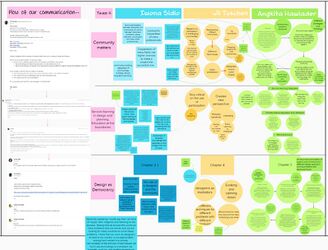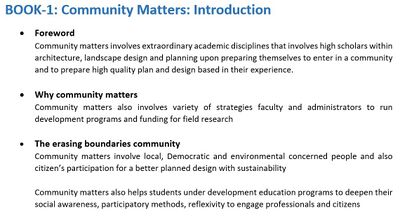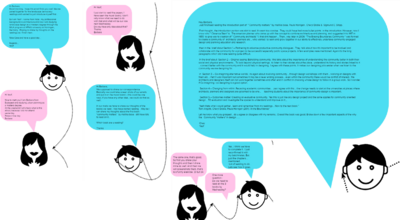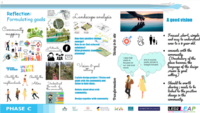LED2LEAP 2021 - Nürtingen Team 5: Difference between revisions
Jil.tuschen (talk | contribs) |
Jil.tuschen (talk | contribs) |
||
| Line 206: | Line 206: | ||
<gallery caption=" " widths="200px" heights="150px" perrow="5"> | <gallery caption=" " widths="200px" heights="150px" perrow="5"> | ||
File:PlaceholderImage_14.jpg|'' | File:PlaceholderImage_14.jpg|''A first attempt at the poster design'' | ||
File:PlaceholderImage_14.jpg|''insert text here'' | File:PlaceholderImage_14.jpg|''insert text here'' | ||
File:PlaceholderImage_14.jpg|''insert text here'' | File:PlaceholderImage_14.jpg|''insert text here'' | ||
Revision as of 17:04, 6 July 2021
>>>back to working groups overview
For help with editing this Wiki page use this link.
For assignments and key readings use this link.
| Area | Steinach River Bank | |
| Place | Nürtingen | |
| Country | Germany | |
| Topics | Making Steinach River accessible to the community | |
| Author(s) | Angkita Hawlader, Yasif Alavi, Christian Barrera, Maximilian Stauch | |

| ||
Landscape Democracy Rationale
- insert text here
Location and Scope
- insert text here
Phase A: Mapping Your Community
Welcome to Your Community and Their Landscape
Groups of Actors and Stakeholders in Your Community
- insert text here
Relationships Between Your Actors and Groups
- insert text here
Summary of Your Learnings from the Transnational Discussion Panel
- insert text here
Theory Reflection
- insert text here
Reflection on theory 'Things that went well':We found the theory of working in PAR spiral very helpful where each step involves assumptions, experimentation, reflection and revised assumption -Starting each process with assumption helped us in moving forward with the mapping exercises since three members from our team are not in Nurtingen - Helped us in being creative in imagining what the people want. -Information about nurtingen was available online as well. Things that were difficult -Online research / working in group online was tiring. Not meeting in person with groups members is different and is taking more time during discussions. -Communicating and talking to people in person and over phone/ Internet is very different
References
- insert text here
Phase B: Democratic Landscape Analysis and Assessment
Angkita Hawlader , Iwona Sidlo and Jil Tuschen Correspondence
Maximilian Stauch and Lena Bartens Correspondence
Yasif Alavi and Barbara Bozsik Correspondence
Christian and Chayma Correspondence
Your Name and Partner's Name Correspondence
- ''insert text here''
Phase C: Collaborative Visioning and Goal Setting
The Scene in Your Story of Visioning
- The challenges of the community was to connect better with the Steinach river . The problems foreseen are climate change, Social disconnection and growing urban area. Our main goal is to connect the community with the river and increase biodiversity at the same time.
The Actors in Your Story of Visioning
- The actors involved with the steinach river are :
1. Unsere Braike ( local community ) 2. Florists 3. Landscape Architects 4.Industry owners
The Story of Visioning
- We start with community mapping , identifying the stakeholders, activate the stakeholders by contacting them through emails, facebook groups and sharing postures regarding our project area. We then listen to their needs and document their voices through illustrations which shows the steinach river in them. We then categories the needs in to thre major goals which are : 1.River sides development 2.Make Riverbanks more accessible 3. Bring communities together.
We then move towards formulating action plans for the goals identified. We then identify the resources needed for our action plan . We work on a three year action plan and also note the tangible indicators of success for year .
Reflect on Your Story of Visioning
- The steps to formulating goals include, community mapping, stakeholder identification , landscape analysis and then engaging with the community . Basic questions to keep in mind when discussing design project , its goals and visions with the community would be :
1. How does positive change emerge? 2.How do we find coherent solutions? 3.What promotes innovative planning?
The characteristics of a good vision would be : 1.Focused ,short, simple and easy to understand even to a 9 year old. 2.Connects with the community. (Vocabulary of the place becomes the language of the design ,vision & goal setting) 3.Should be worth sharing ; needs to be linked to the positive change in the community.
Phase D: Collaborative Design, Transformation and Planning
Your Prototyping Action
The prototype action phase started with developing a tool that shows a possible future design on the Steinach River towards the local community. To be able to show the visions clearly, the decision was made to use multiple posters. This created the opportunity to represent multiple ideas and get feedback at the same time. A good poster does not only communicate the message clearly but also quickly, because the poster(s) represent the necessities of the visions. The posters are also able to capture attention and stimulate a discussion.
The Evolution of Your Prototyping Action
In the first step, several designs were tested. In the first testing phase, one poster with multiple images and visuals was printed. Unfortunately, this design did not fit a regular landscape format. After shaping and printing several times a fully new design was created. This new design included three different posters where only one vision of a specific location along the Steinach was shown. It also included a more simplistic voting system. After finishing this design the three A4 posters were printed and laminated.
In the next step, the location was decided. A busy cross point along the Steinach seemed optimal. Once the location was chosen all the materials needed to be collected. Since the choice was made to hang the posters on the railing of the bridge, only the posters, stickers, a thread, and scissors were needed. This arrangement ensured that the posters would stay dry even after a larger rainfall.
The last step was to start a conversation with people that walked by. After a brief introduction of the project and the posters, the conversation quickly moved on to the desired feedback. The created poster is also able to stand alone and still provides an explanation.
The Plan Behind Your Prototyping Action
Throughout the project, our team has included the opinion of the local community within multiple phases. We are planning on continuing this until the end of the project. This way we can develop a design that is sufficient within meeting the needs of its users. The idea of this feedback event is relatively straightforward. The posters that are displayed show multiple possible designs of different locations along the river. When pedestrians walk by they are asked if they are interested in sharing their opinion on one or multiple posters. They can do this verbally by means of comments or ideas on the poster or by putting stickers on the poster. These stickers show depending on the color and position if they liked or disliked the concept.
The Realization of Your Prototyping Action
The realization of this feedback event went as aspected. Since the weather has been very changeable over the past few days, we took the action relatively spontaneously. As a result, the action took place on a Monday afternoon. This ensured that a diverse number of people could be addressed, which varied between students, workers, or people who were just going for a walk. Depending on their time constraints, they provided deeper or superficial feedback, any kind of feedback helped here.
Reflect on Your Prototyping Action
- insert text here
Phase E: Collaborative Evaluation and Future Agendas
Collaborative Evaluation and Landscape Democracy Reflection
- insert text here
The Actors in your Collaborative Evaluation
- insert text here
Reflection on the Online Seminar
- insert text here
Reflection on the Living Lab Process
- insert text here
Your Living Lab Code of Conduct
- insert text here
Process Reflection
- insert text here







































